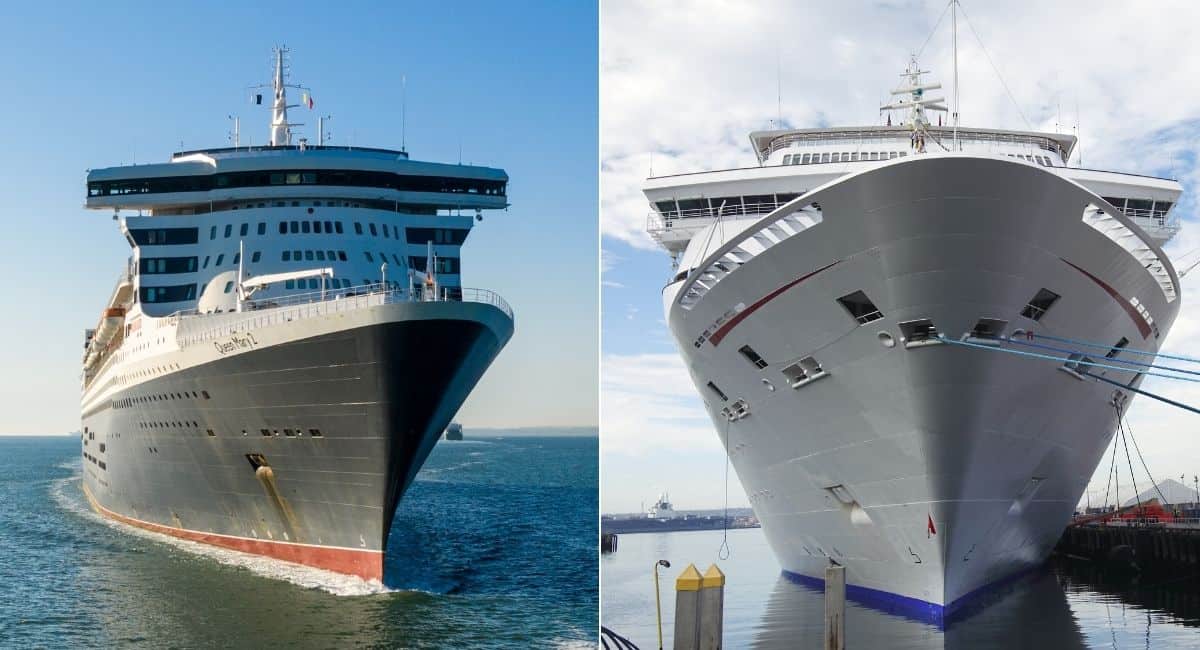
Liners are ships which ply on a fixed route and/or between fixed ports. Liners can be cargo ships or passenger ships, although “ocean liner” is specifically used for passenger ships.
There are some similarities between ocean liners and cruise ships. They are both large, sea-going passenger ships, although ocean liners are generally large, and cruise ships could also be smaller in size. An ocean liner could also be used as a cruise ship, but not all cruise ships can be used as ocean liners. We will discuss the reasons below.
Ocean liners are typically constructed to undertake transcontinental voyages between specific ports, for example, a trans-Atlantic journey between Southampton in the UK and New York in the USA. Cruise ships are used for shorter trips closer to land that may touch many ports. They rarely, if at all, venture out to the open ocean.
In essence, the primary purpose of building ocean liners was transportation. Until air transportation became common, travel between continents was undertaken by sea, using ocean liners.
In addition, in the 19th century and early 20th century, ocean liners were engaged to carry mail as part of the Royal Mail Service of the British Government. For this reason, many iconic ocean liners’ names were prefixed with RMS, such as RMS Titanic, RMS Carpathia etc., which stood for Royal Mail Ship.
Ocean Liners VS Cruise Ships
As air travel became cheaper and more common, ocean liners gradually became obsolete. Queen Elizabeth, Queen Mary, Queen Victoria, Queen Elizabeth 2, Queen Mary 2, Marco Polo etc., are the names of some famous and legendary ocean liners. Currently, only one ocean liner that still operates on trans-Atlantic voyages is the Queen Mary 2.
Cruise ships, instead, are used more for tourism and recreational purposes and not so much for transportation. This is why most modern cruise ships are seen as massive and luxurious floating hotels, which house many restaurants, casinos, spas, clubs and other entertainment options.
Ocean Liners form the basis of today’s cruise industry. Most of today’s leading cruise lines started with large ocean liners. Even today, many cruise ship designs are based on ocean liners. However, many do not undertake trans-continental voyages often, and a few only do it for seasonal repositioning.
The reason for the above could be simple economics. Cruise ships bring more revenue due to guest-centric amenities. Most guests prefer shorter, local round voyages instead of long trans-continental voyages, mainly due to a lack of time and job commitments.
Also, ocean liners cost more due to the more rigid construction and speed requirements than cruise ships. Therefore, it is more profitable to run cruise ships.
Since both ships have different purposes, they are designed very differently.
Design and Construction
Under the very nature of their operations, Ocean liners are designed predominantly with safety and watertight integrity. They are very rigid in construction than cruise ships to withstand extreme sea and weather conditions, which they may encounter during long intercontinental voyages.
A longer bow, a thicker hull, and a much higher speed (up to 30 knots) to keep up schedules amidst adverse sea conditions are some traits of an ocean liner. In contrast, cruise ships are designed and constructed in a guest-centric manner with more focus on hotel amenities, pleasure and entertainment. Some of these differences are discussed below.
An ocean liner rests lower in the water, which makes it more capable of withstanding heavy weather and rough sea conditions. The bow tends to be longer to protect the superstructure against waves. A cruise ship, in contrast, generally sits higher in the water and is more vulnerable to weather changes.
An ocean liner is constructed with the extra thickness of steel to withstand the force of waves, improve its stability and support its weight. The steel tends to be several inches thicker than that found on cruise ships, generally of standard thickness.
Ocean liners have more aerodynamic designs enabling them to wade quickly through the water. This is required as they go on scheduled voyages between two ports, which need more speed.
Schedules on an ocean liner need to be maintained despite weather changes. The destination takes priority over the experience itself. On the contrary, Cruise ships move at a standard speed due to the passengers on board. The activities and experiences of the cruise voyage tend to be prioritised over the destination.
The navigation bridge on an ocean liner rests as far above as possible. This is to provide a good view and protect the bridge and navigation equipment in the event of a storm and inclement weather conditions.
Since ocean liners experience heavy seas, especially during ocean crossings in the winter, the boat deck is closer to the ship’s top, allowing the boats to be better protected from the waters.
The legacy of British ocean liners
As the discussion involves ocean liners, mentioning Cunard Lines is imperative. This British company has a glorious history and legacy attached to ocean liners. Although known as a cruise line today, Cunard historically has pioneered the ocean liner business, having over 180 years of history dating back to 1840 and having owned hundreds of ocean liners.
Cunard Lines originally started as a trans-Atlantic mail and passenger service, revolutionising the movement of passengers, goods and mail between Britain and North America. When aeroplanes were still relatively unknown, the sea was the primary mode of transportation between continents.
Cunard’s heritage is built on safety, speed and luxury. Historically, it prides itself on owning and running some of the fastest and biggest ocean liners of their times. Even as far back as the early 20th century, their ships, Lusitania and Mauritania, were known to be the fastest ocean liners in the world, making as much as 24 knots and fitted with modern turbine-driven propulsion.
Post the Second World War, two of its most famous and legendary ships, Queen Elizabeth and Queen Mary, epitomised luxury and were also known to be the fastest and biggest ocean liners in the world. They made speeds of over 30 knots each, a feat even today.
However, in the second half of the 20th century, the popularity of ocean liners received a severe blow with the advent of jet aircraft. As time became a critical factor in people’s lives and businesses, aircraft, which could take you to another continent in a matter of a few hours, as opposed to ocean liners which could take several days or even weeks, attained massive popularity.
This forced Cunard, faced with the prospect of a rapidly sinking business, to change focus from the ocean liner business to cruise ships and recreational voyages to secure their business.
However, despite declining popularity, with a diminishing fleet, Cunard continued to run some of its ships on the trans-Atlantic route, as they still offered unparalleled luxury and a welcome change for a few from the mundanity of air travel.
Today, the Queen Mary 2, known as the world’s largest ocean liner, still operates on the trans-Atlantic route, even after having made hundreds of such voyages. In addition, it has also done many world cruises and continues to do them without any compromise on safety and luxury.
It is the last remaining ocean liner still in service and serves as the flagship vessel of Cunard Lines, having taken on that baton from Queen Elizabeth 2, which has now been retired from sea service.
Queen Elizabeth 2, another iconic Cunard ship, carried their legacy before Queen Mary 2. It is said to have completed over 1000 voyages during its near 40 years of service life. It is presently immortalised as a floating hotel in Dubai since 2018, showcasing to the general public and passenger ship enthusiasts Cunard’s rich tradition and history with ocean liners.
In addition to the Queen Mary 2, Cunard operates two more ships presently, Queen Victoria and Queen Elizabeth. These are known purely as cruise ships. One more cruise liner, Queen Anne, is set to join the Cunard fleet soon.
Therefore, I hope that the article was informative and that the differences between cruise ships and ocean liners are clear to the readers.
Follow us on Facebook/ twitter














